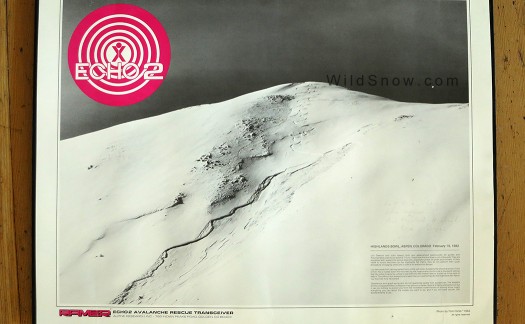Yesterday, I had a serendipity encounter with a guy who saved my life. Today, back in 1982 I lay in a hospital bed with a broken femur and my right gluteus muscle balled up in a useless lump where it was ripped from my pelvis like so much torn paper. My neck was sore, too. If the bleed-out from the femur hadn’t killed me, hypothermia while waiting for a rescue most surely would have.

(Click image to enlarge) About that guy who saved my life. There was more than one, of course. But ski patroller Tom Hicks was instrumental. He was living in his camper at the Highlands ski area base parking lot, and organized the rescue after he got the call-- the call that resulted from local Bob Limacher who happened to be using a telescope to look at the bowl that morning, and saw Izo and I up there skiing. If Bob had not seen us, the rescue would have been at least an hour later or longer. Izo had climbed back up out of the bowl and skied down to Highlands base in record time, but if he'd been the first notification that might have been too late. Back to Hicks. Yesterday I saw him at the grocery store of all places. (Or, actually, it was Whole Foods -- where you see everyone.) A chance encounter, but perhaps not so much chance as destiny. Tom is in his 70s and still ski patrolling. By now he's probably saved a lot of lives. His is a life well lived. He snapped the shot in the poster above, showing my tracks leading into the slide. The image was used by Paul Ramer, one of the early avalanche beacon (Echo 2) makers and pioneer of alpine touring backcountry skiing bindings. Limacher is still around as well. I see him at the ski resorts every few years.
I’d messed up. Big. In some stupid state of sunrise euphoria enhanced by testosterone poisoning I’d skied my way directly into a cross loaded avalanche path. The slope ripped fast and raked me over boulders at 90 mph for 1,300 vertical feet.
My story was told long ago, from words muttered from my hospital bed. Today, memories rise like the foam on a mountain river, at once peaceful, yet turbulent, random.
I leave my friend Izo near the top. As he watches, I ski over an old filled-in fracture. The snow texture changes under my skinny 1980s skis. “This is not good. I’ll pull out over here at the top…” The fracture opening in front of me is burned into my neurons like a cattle brand. The avalanche takes me fast. I watch for about a second as it pulls big blocks of windslab from sidewall. Then it’s all roaring, tumbling with those same horse sized cubes of snow.
No body control. I’m a ragdoll. When my femur breaks my whole body vibrates like a tuning fork. This is only half way down. During the rest of the fall my leg is torqued and twisted in ways not even a medieval torture expert could conjure.
When the slide stops, it feels like stabbing the brakes in a high-end sports car. My lower body it buried a few feet deep. Is my leg gone? Amputated? I watch Izo work his way down the path. He can’t see me. I have no strength to shout. It happens too fast, when you’re life starts to seep out like water draining from a wrung-out dish towel hung up to dry. You think of people you love, how you failed them — how you failed yourself. And sometimes you survive to think about those feelings years later.
I lived through that avalanche as a changed man, with a sense of purpose that led to guidebooks, family, focused spirituality and ultimately the effort you see here at WildSnow.com to inform, to entertain — and yes, to help all of you come back alive from your backcountry adventures. Please do.
What can I offer today? When you are out there skiing the wild snow, think about the consequences. Be risk averse. If you have the slightest doubt pick a safer route, a lower angled descent, an exposure with safer snow. Live to ski — another day.
WildSnow.com publisher emeritus and founder Lou (Louis Dawson) has a 50+ years career in climbing, backcountry skiing and ski mountaineering. He was the first person in history to ski down all 54 Colorado 14,000-foot peaks, has authored numerous books about about backcountry skiing, and has skied from the summit of Denali in Alaska, North America’s highest mountain.
